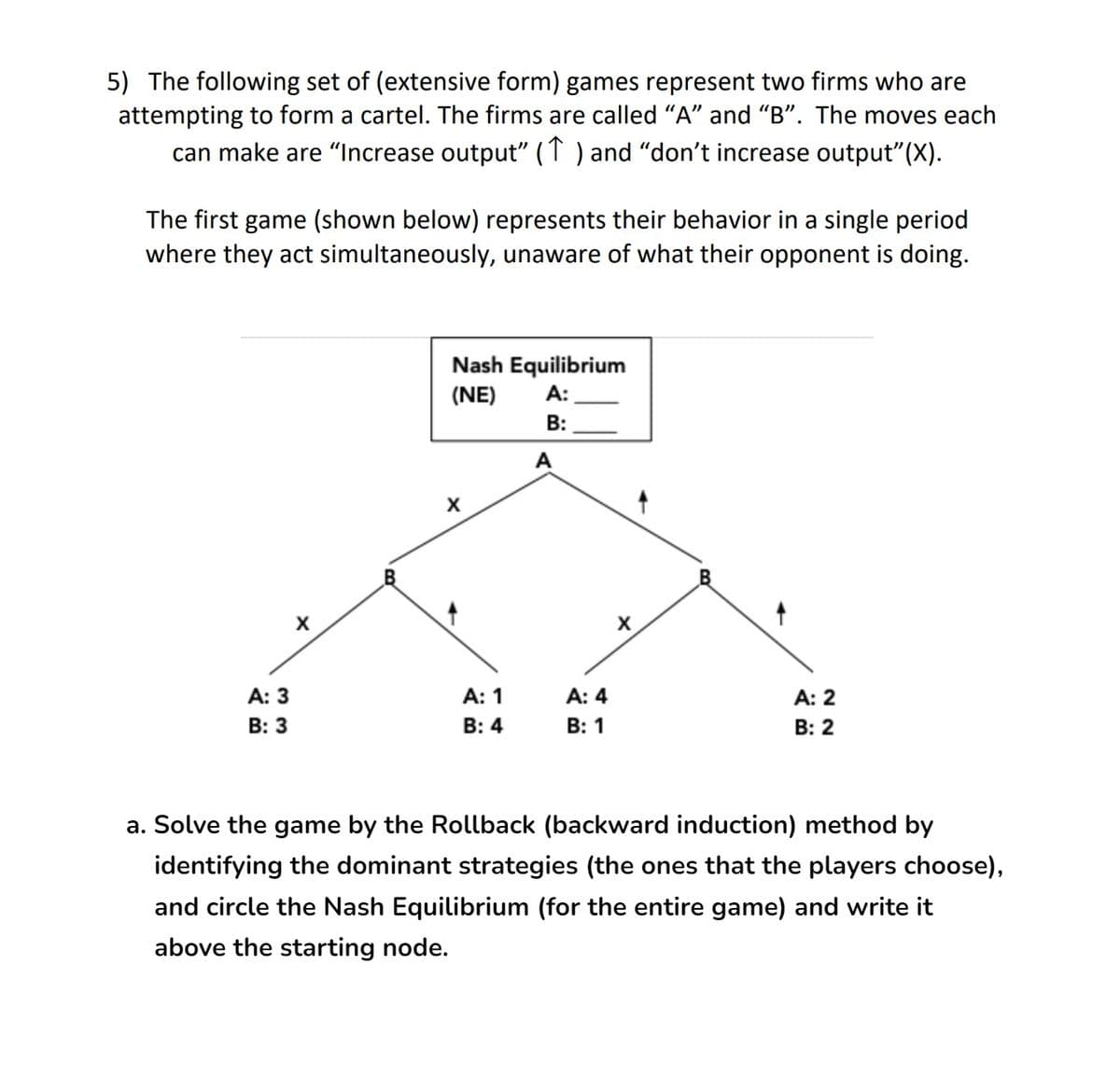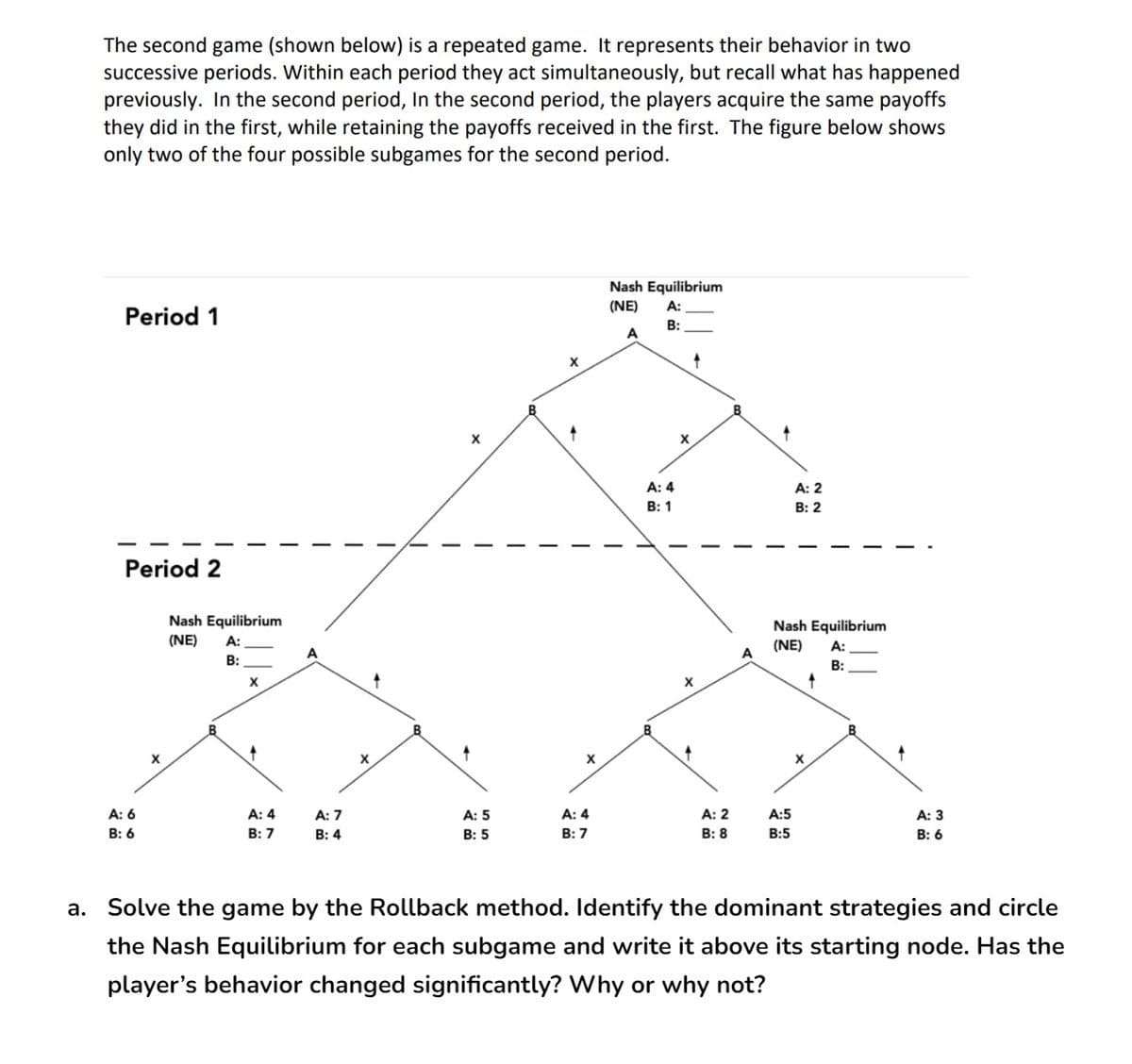5) The following set of (extensive form) games represent two firms who are attempting to form a cartel. The firms are called "A" and "B". The moves each can make are "Increase output" (1) and "don't increase output" (X). The first game (shown below) represents their behavior in a single period where they act simultaneously, unaware of what their opponent is doing.
5) The following set of (extensive form) games represent two firms who are attempting to form a cartel. The firms are called "A" and "B". The moves each can make are "Increase output" (1) and "don't increase output" (X). The first game (shown below) represents their behavior in a single period where they act simultaneously, unaware of what their opponent is doing.
Chapter15: Oligopoly And Strategic Behavior
Section: Chapter Questions
Problem 17P
Related questions
Question
This is a 2-part question that requires the answer before in order to answer the next one. Thank you for your time.

Transcribed Image Text:5) The following set of (extensive form) games represent two firms who are
attempting to form a cartel. The firms are called "A" and "B". The moves each
can make are "Increase output" (1) and “don't increase output" (X).
The first game (shown below) represents their behavior in a single period
where they act simultaneously, unaware of what their opponent is doing.
Nash Equilibrium
(NE)
A:
B:
A: 3
A: 1
A: 4
A: 2
B: 3
B: 4
B: 1
B: 2
a. Solve the game by the Rollback (backward induction) method by
identifying the dominant strategies (the ones that the players choose),
and circle the Nash Equilibrium (for the entire game) and write it
above the starting node.
X
X
A
X

Transcribed Image Text:The second game (shown below) is a repeated game. It represents their behavior in two
successive periods. Within each period they act simultaneously, but recall what has happened
previously. In the second period, In the second period, the players acquire the same payoffs
they did in the first, while retaining the payoffs received in the first. The figure below shows
only two of the four possible subgames for the second period.
Nash Equilibrium
(NE)
A:
Period 1
B:
A
Period 2
Nash Equilibrium
(NE)
A:
B:
X
X
X
X
A: 4
B: 1
X
↑
X
A: 6
A: 4
A: 7
A: 5
A: 4
A: 2
A:5
A: 3
B: 6
B: 7
B: 4
B: 5
B: 7
B: 8
B:5
B: 6
a.
Solve the game by the Rollback method. Identify the dominant strategies and circle
the Nash Equilibrium for each subgame and write it above its starting node. Has the
player's behavior changed significantly? Why or why not?
A: 2
B: 2
Nash Equilibrium
(NE)
A:
B:
Expert Solution
This question has been solved!
Explore an expertly crafted, step-by-step solution for a thorough understanding of key concepts.
This is a popular solution!
Trending now
This is a popular solution!
Step by step
Solved in 2 steps with 2 images

Knowledge Booster
Learn more about
Need a deep-dive on the concept behind this application? Look no further. Learn more about this topic, economics and related others by exploring similar questions and additional content below.Recommended textbooks for you

Exploring Economics
Economics
ISBN:
9781544336329
Author:
Robert L. Sexton
Publisher:
SAGE Publications, Inc

Principles of Economics (MindTap Course List)
Economics
ISBN:
9781305585126
Author:
N. Gregory Mankiw
Publisher:
Cengage Learning

Principles of Economics, 7th Edition (MindTap Cou…
Economics
ISBN:
9781285165875
Author:
N. Gregory Mankiw
Publisher:
Cengage Learning

Exploring Economics
Economics
ISBN:
9781544336329
Author:
Robert L. Sexton
Publisher:
SAGE Publications, Inc

Principles of Economics (MindTap Course List)
Economics
ISBN:
9781305585126
Author:
N. Gregory Mankiw
Publisher:
Cengage Learning

Principles of Economics, 7th Edition (MindTap Cou…
Economics
ISBN:
9781285165875
Author:
N. Gregory Mankiw
Publisher:
Cengage Learning

Principles of Microeconomics (MindTap Course List)
Economics
ISBN:
9781305971493
Author:
N. Gregory Mankiw
Publisher:
Cengage Learning


Managerial Economics: A Problem Solving Approach
Economics
ISBN:
9781337106665
Author:
Luke M. Froeb, Brian T. McCann, Michael R. Ward, Mike Shor
Publisher:
Cengage Learning